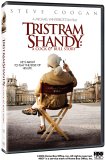| Reviews & Columns |
|
Reviews DVD TV on DVD Blu-ray 4K UHD International DVDs In Theaters Reviews by Studio Video Games Features Collector Series DVDs Easter Egg Database Interviews DVD Talk Radio Feature Articles Columns Anime Talk DVD Savant Horror DVDs The M.O.D. Squad Art House HD Talk Silent DVD
|
DVD Talk Forum |
|
|
| Resources |
|
DVD Price Search Customer Service #'s RCE Info Links |
|
Columns
|
|
|
Tristram Shandy - A Cock and Bull Story
THE MOVIE:
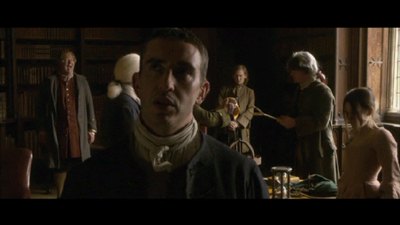
When the Big Man Behind DVDTalk handed me the DVD of Michael Winterbottom's Tristram Shandy: A Cock & Bull Story, he flashed me his million-dollar smile and said, "Good luck with that."
Sensing I had somehow just been tricked, I asked, "What do you mean?"
The Big Man shot a look at the Big Bruiser he had with him (security is important in the world of DVD reviews), and the Big Bruiser winked back. He, too, was in on the joke. "The unfilmable book has now become the unreviewable DVD," the Big Man said. "You've got quite a task ahead of you."
Oy vey, was he ever right. Just how does one approach the film of Tristram Shandy? Less of a straight adaptation than an homage to the style of the source material, director Winterbottom, writer Martin Hardy, and actor Steve Coogan have left much of the narrative behind in an attempt to capture what makes Laurence Sterne's 18th-century novel, The Life and Opinions of Tristram Shandy, Gentleman, still so important today. They walk a self-reflexive tightrope that is constantly under danger of snapping, which would cause them to tumble into the net of too-clever-by-half. When does being aware of what you are doing become too aware for its own good? And what if I sink into the same smart-guy swamp by trying to write about the DVD? Is it too late? Did that introduction even work?
You see, midway through the film, when Steve Coogan has painted himself into a corner by pretending to have read the novel when he has not, I realized I could end up being him if I strayed too far from the film. I could attempt to relive my undergraduate experience and tell you all about how Sterne predicted postmodernism by two centuries--and the movie even enlists Stephen Fry to come in and give us all a crash course on Sterne's themes and technique--but I'm inevitably going to get it wrong, because I've never actually read the book. Sure, it came up multiple times in my college career, and I even have a copy sitting on my bookshelf in the other room, but I've never cracked it open. It's really long, and it's one of those books that people always talk about, and I've always felt like I've read it, so it's become one of those things I've always been able to fake. It's kind of like Birth of Nation. "Sure, sure. D.W. Griffith, the KKK, Abraham Lincoln...loved it. Loved it." "Wasn't Lillian Gish wonderful in that?" "Hmmm? Oh, yes...which one was she again?"
So, I'll admit it. I'm in the dark. I'm stuck on the black screen that the screenwriter in the film (Ian Hart), whose part was presumably written by the actual screenwriter, tells us is a direct lift from the black page used in the book. I'll have to take him at his word that it's really there.
What, then, are we left with when we consider the prospect of Tristram Shandy: A Cock & Bull Story? Well, that's actually more simple than the Big Man would have led me to believe. Tristram Shandy is a multilayered comedy about the absurdity of the creative process, which one character, Jennie (Naomie Harris), kindly informs us is a metaphor for life. Novels and films can't capture the real human experience, because it's ungraspable. Try to nail it down, and it shifts on you; try to predict it, and you end up with egg on your face.
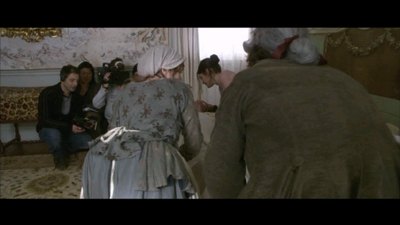
Tristram Shandy: A Cock & Bull Story concerns itself with a couple of days of shooting on the set of the film of Tristram Shandy: A Cock & Bull Story. Coogan plays both Tristram and Tristram's father, and he also plays himself. He narrates the experience both as the character of Tristram and as the character of Steve Coogan, one filling us in when we are seeing the actual "filmed" moments, the other keeping us abreast here and there in the "behind-the-scenes" footage. Other actors, such as Rob Brydon and Gillian Anderson, play themselves, as well, whereas still more actors play the crew that we are supposed to accept as being part of the film process and just as real as Coogan and the rest on that side of the fictional line. It's all documentary, right? Like Lost in La Mancha in England? Except, no, we know that Jeremy Northam is Jeremy Northam, not Michael Winterbottom (or Mark, as he is named in the film), and Kelley MacDonald, whom we've all had a crush on since Trainspotting, is not really Coogan's girlfriend Jenny, nor the mother of his child. Further adding to the illusion, Tony Wilson, whom Coogan portrayed in 24 Hour Party People, shows up as himself to interview Coogan on set, while Kieran O'Brien plays a fictional reporter also in pursuit of a story. Where does invention end and the documentary begin? Does it matter? Was the narration over the Tony Wilson scene that tells us the full interview will be on the DVD written in the script? I don't know, but the interview is one of the bonus features. Someone somewhere along the line was thinking ahead!
When Tristram Shandy: A Cock & Bull Story works--and it doesn't work all the time--it's usually down to Coogan. He's a charismatic presence, and here he's not afraid to play "himself" as an insecure actor whose own hubris is going to consistently trip him up. With Brydon as his comic foil, doing horrible impressions of him and snatching the good opportunities away as soon as they pop up, Coogan ends up being a hapless victim in the thematic chaos. Even as he fights for the redemption in the father character he plays, he is ensnared in the same traps he frets over--and ultimately frees himself from them by the same measure. In this aspect, it's less Lost in La Mancha, but more like a version of Spike Jonze and Charlie Kaufman's Adaptation that escapes indicting itself, and by turns, let's the audience off the hook, as well.
This is not a movie for everyone. Your ability to enjoy Tristram Shandy: A Cock & Bull Story will depend on how much you wanted to beat up the smart kid in school who knew how smart he was and always tried to lord it over you. The movie isn't quite as smarmy as all that, more like a comedian who has a pretty good self-image and thinks he knows how funny he is. Can you get past the smugness and recognize that he's right? I could, and so I liked a lot of the picture. Then again, if you can't be won over by the bit with the hot chestnut down the pants, you may be too grumpy for your own good anyway.
But what if we keep up this exercise we've got going here, and by connection, the exercise of the filmmakers, and we extend the experience. We're not just watching a film about people trying to make the film of a famous novel, but we're watching a DVD of the film and in that film, the characters are aware that there will eventually be a DVD version. This means that, with all the DVD extras, we really go behind the scenes of a movie that fakes being a film about the behind the scenes elements of a movie. Can this hall of mirrors hold?
(Yes, I am going to skip ahead and talk about The Extras. Try and stop me, Big Man Behind DVDTalk.)
The special features on the disc range from the standard to the insightful, and all have a little dig at the "reality" of what we are doing. Of course, there is the promised extended interview between Steve Coogan and Tony Wilson. Coogan is fascinating as he tries to dissect the various characters he plays, from his TV days as fake talk show host Alan Partridge up until now. He seems to be weaving in and out of the layers of the Tristram Shandy experience, alternately talking about the fictional life of the Steve Coogan of the film as if it were real and then knocking down the walls to talk about his real-life relationship with Rob Brydon. This happens again in a deleted/extended scene where Wilson interviews Brydon, and he mentions receiving a script for Tristram Shandy that had his name in it--as a character.
Other deleted scenes are what you'd expect: the crew playing around and exploring other avenues. There is a long conversation between Coogan and Brydon, the leftovers from their closing credits sequence, and there is also a scene where Tristram meets death. The existence of these tidbits, some of which could just as easily be a part of a real electronic press kit (and for all I know, were), continue to foster the idea that this is real. Not reality TV, but reality movie making: we watch a tightly scripted program while being led to believe we are flies on the wall to true human disaster.
The section actually called "Behind-the-Scenes Footage" is partially a letdown. There could have been some delicious tricks played on the viewer through faked real footage or even actual on-set happenings that would have blurred reality further. Why not a scene of the real Michael Winterbottom directing his onscreen counterpart, for instance? Of the two snippets, the footage of the battle scene is somewhat superfluous, as it just becomes a montage under orchestral music.
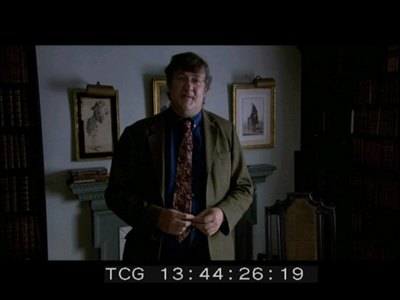
Much better is the featurette of Stephen Fry taking a tour of Laurence Sterne's home and discussing the author and his book with the caretaker there. Once again, this isn't really a behind-the-scenes moment, as it is referred to in the final edit of the film and a piece of the tour is used. For those wanting to be more educated in Sterne-lore, however, it's full of great information, exposing how deep some of the jokes go and also illustrating through anecdote how the writer's own life bore out the themes of his greatest work. And, of course, it's interesting that it's presented here as a real sort of documentary, since in the parts used in the main body of the film, Fry is referred to as a fellow named Patrick, the curator of the house. Reality, fiction.
Where the DVD can really go deep into the layers of the facade is on the audio commentary. Here Coogan and Brydon are themselves talking about playing themselves and making a movie that is about making a movie. Sometimes the two actors blatantly expose the lines, such as explaining that Shirley Henderson has invented an entirely different persona for being herself in the movie, forgetting fake crew members weren't real crew members, or referring to how some of the "documentary" scenes were written in the script; other times, it's hard to tell whether the anecdote they are relating is a true story or an added bit of folklore for a movie that is already playing with our perceptions. Coogan and Brydon seem to both be riffing on the personas they created for the picture--even while questioning whether it was smart to portray themselves as neurotic and vain--and bouncing off a genuine friendship. It speaks to the smartness of the casting, and one actually leaves the commentary with a greater respect for Michael Winterbottom. I found it fascinating listening to Coogan talk about how real meetings with investors ended up being transcribed for the screenplay. There is even a scene in Tristram Shandy where Coogan the Character requests a scene be added for the Walter Shandy role that turns out to be inspired by Coogan the Actor requesting the same scene for Coogan the Character. Winterbottom inserted both the request and the scene itself, making the cake and letting Coogan eat it, too.
The commentary achieves its most exposed picture-within-a-picture at the closing credits. Winterbottom shot the two actors discussing the film in a screening room, still playing their own doppelgangers, and this improv runs next to all the crew names. Now, with the commentary, we go further into the illusion. They actors aren't just sitting in a room talking about themselves playing the roles of themselves, but they are sitting in a room talking about sitting in a room talking.
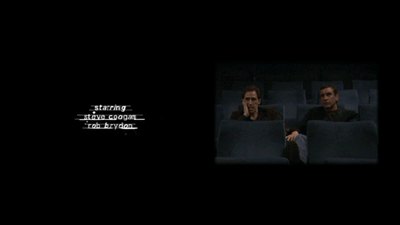
It's all about the prank, the playful nature of putting something like this together. Tristram Shandy: A Cock & Bull Story is about the idea of a movie, about how these crazy things are crafted, and about tweaking the medium the way Laurence Sterne's novel was about prose and the nature of printing. There are a lot of plates to keep spinning, and sure, a few break, but it's fun watching them perched up there, and sometimes even the shattering is good for a laugh.
(How's that, Big Man Behind DVDTalk? Did I review the unreviewable, or did I simply write the unreadable?)
THE DVD
Video:
Tristram Shandy: A Cock & Bull Story has a 16:9 aspect ratio and the picture is lovely. When Steven Coogan climbs into the giant fake womb, you can see the garish reds and the condensation from his breath, and it makes you feel like you're also suffocating in a giant fake womb. That, kids, is quality.
The DVD has pretty cool animated menus done in a style reminiscent of Terry Gilliam's cartoons for the old Monty Python shows.
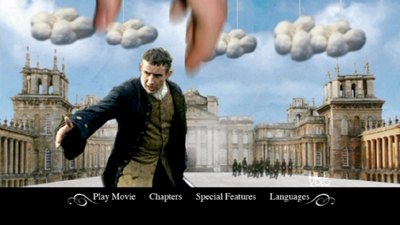
Sound:
A 5.1 sound mix that's nicely done. This movie is reliant on dialogue, so there are not a lot of tricks needed--though, when a dream sequence is inserted to illustrate Coogan's feeling of losing control (wait a minute, how is there a dream sequence in a documentary?), there are some effective abstract sounds that come across with the same unsettling effect as intended.
Fair Warning: Some of the extras have pretty inconsistent sound. This is understandable for the true deleted scenes, but kind of frustrating for the extended interviews. Still, minor imperfections that only creep in for a moment or two.
Extras:
Did I not focus on this enough in the review itself? Yeesh. Okay, maybe I neglected to mention the theatrical trailer, which is actually pretty good and is a lively representation of what Tristram Shandy: A Cock & Bull Story is really like. If you saw that, thought it looked good, and went to the movie as a result, I suppose you could still have ended up being disappointed, but you couldn't say you had no idea what you were getting yourself into.
FINAL THOUGHTS:
Highly Recommended. Anyone with an interest in filmmaking, deconstructionism, or the slapstick inherent in knocking the wind out of the sails of the pompous will enjoy the playful joke that is Tristram Shandy: A Cock & Bull Story. In terms of total package, the DVD provides a strong clutch of extras that enhance the overall viewing, and as with all smart comedies, digging deeper is rewarded as more subtle jokes come through. Coogan is always a pleasure to watch, and he's backed here by a tremendous supporting cast. Given what a fun afternoon I had with the film, it may be time to finally dust off my Tristram Shandy paperback, which is truly the mark of a good adaptation: it makes you want to read the book. That is, unless some publisher out there commissioned a novelization of the film. Then I might just go out and get that. Then I could write another piece about reading the book of a movie of a book and see how much farther I could take that.
Anyway, get this DVD. It's good.
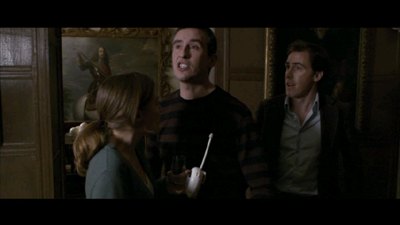
Jamie S. Rich is a novelist and comic book writer. He is best known for his collaborations with Joelle Jones, including the hardboiled crime comic book You Have Killed Me, the challenging romance 12 Reasons Why I Love Her, and the 2007 prose novel Have You Seen the Horizon Lately?, for which Jones did the cover. All three were published by Oni Press. His most recent projects include the futuristic romance A Boy and a Girl with Natalie Nourigat; Archer Coe and the Thousand Natural Shocks, a loopy crime tale drawn by Dan Christensen; and the horror miniseries Madame Frankenstein, a collaboration with Megan Levens. Follow Rich's blog at Confessions123.com.
|
| Popular Reviews |
| Sponsored Links |
|
|
| Sponsored Links |
|
|
| Release List | Reviews | Shop | Newsletter | Forum | DVD Giveaways | Blu-Ray | Advertise |
|
Copyright 2024 DVDTalk.com All Rights Reserved. Legal Info, Privacy Policy, Terms of Use,
Manage Preferences,
Your Privacy Choices | |||||||









